SUBARU TRIBECA 2009 1.G Service Workshop Manual
Manufacturer: SUBARU, Model Year: 2009, Model line: TRIBECA, Model: SUBARU TRIBECA 2009 1.GPages: 2453, PDF Size: 46.32 MB
Page 1881 of 2453
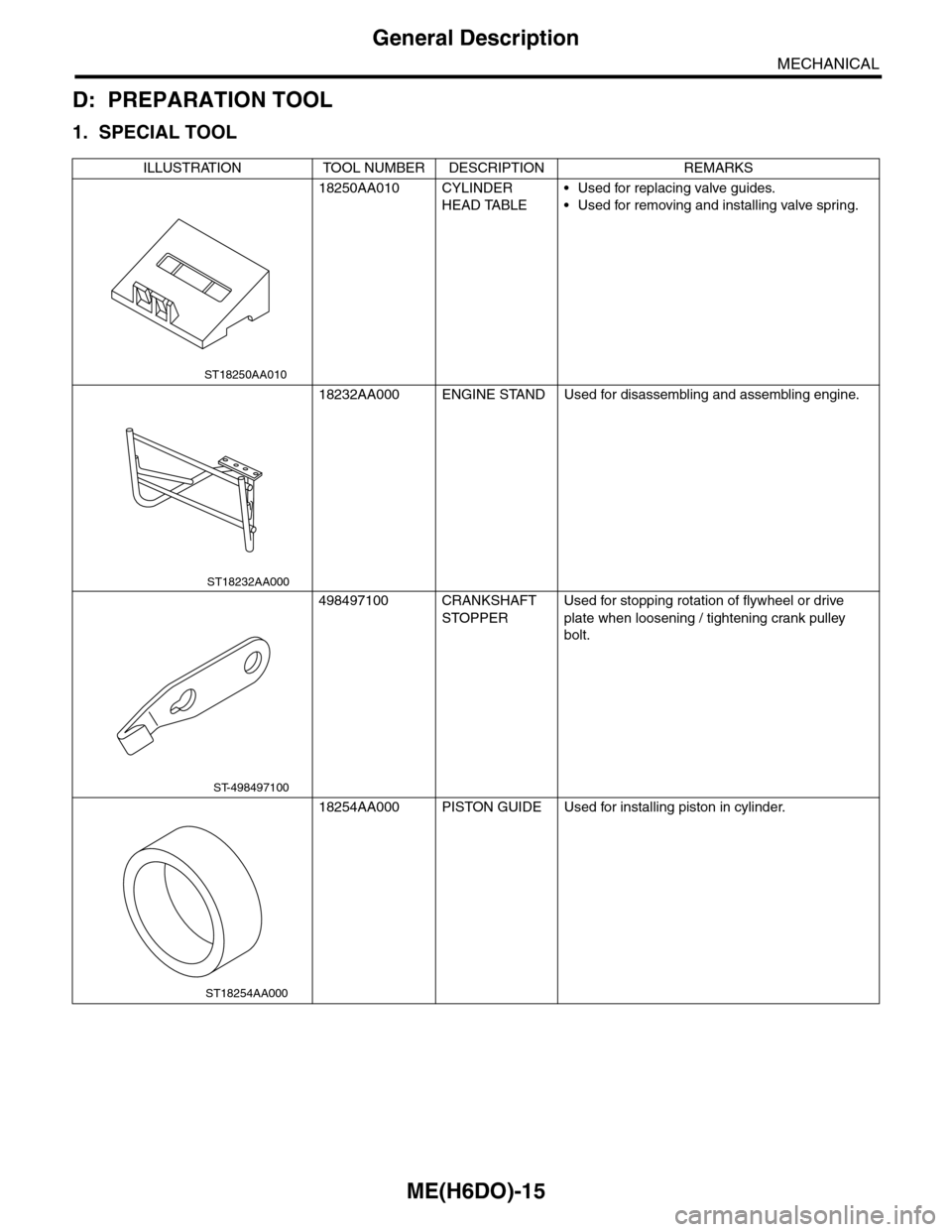
ME(H6DO)-15
General Description
MECHANICAL
D: PREPARATION TOOL
1. SPECIAL TOOL
ILLUSTRATION TOOL NUMBER DESCRIPTION REMARKS
18250AA010 CYLINDER
HEAD TABLE
•Used for replacing valve guides.
•Used for removing and installing valve spring.
18232AA000 ENGINE STAND Used for disassembling and assembling engine.
498497100 CRANKSHAFT
STOPPER
Used for stopping rotation of flywheel or drive
plate when loosening / tightening crank pulley
bolt.
18254AA000 PISTON GUIDE Used for installing piston in cylinder.
ST18250AA010
ST18232AA000
ST-498497100
ST18254AA000
Page 1882 of 2453
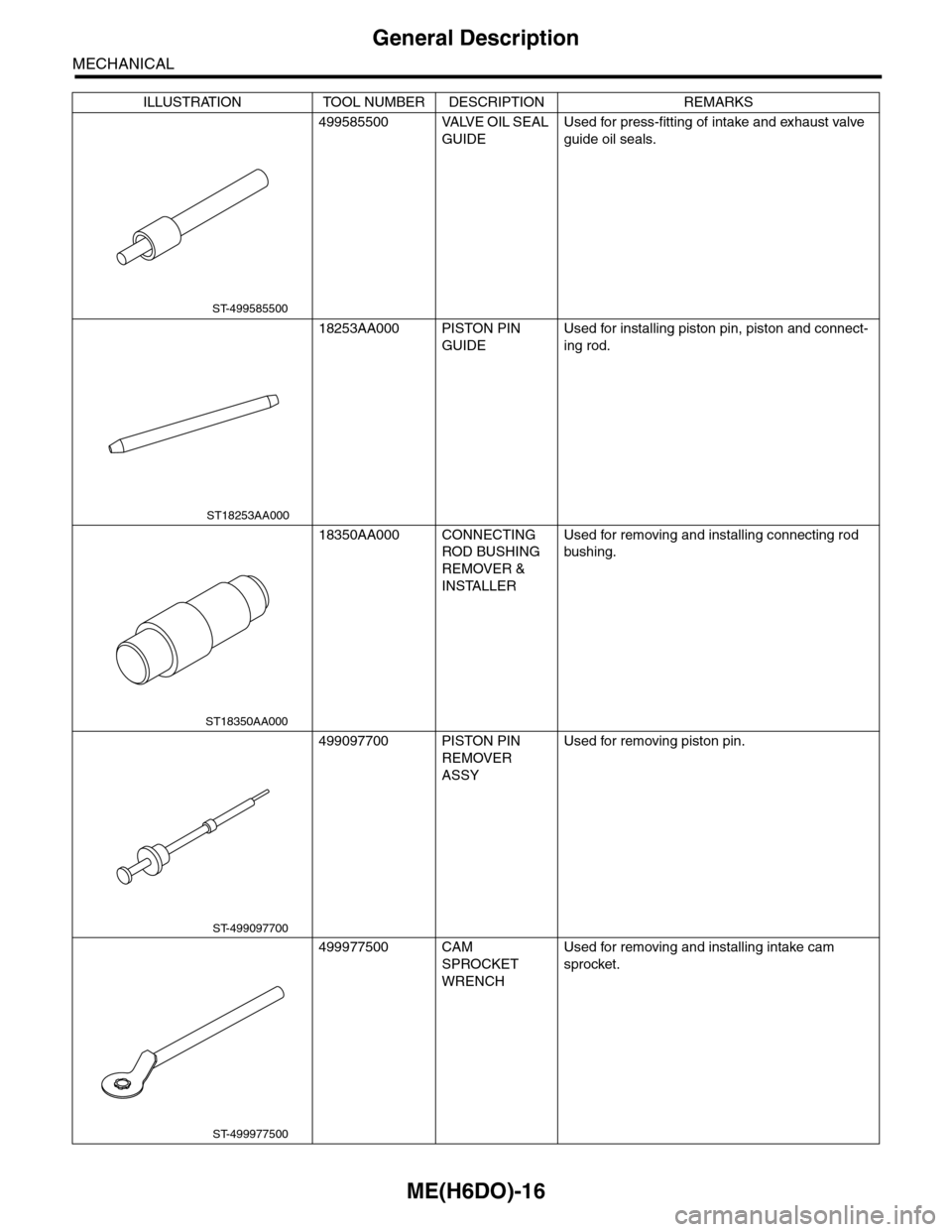
ME(H6DO)-16
General Description
MECHANICAL
499585500 VALVE OIL SEAL
GUIDE
Used for press-fitting of intake and exhaust valve
guide oil seals.
18253AA000 PISTON PIN
GUIDE
Used for installing piston pin, piston and connect-
ing rod.
18350AA000 CONNECTING
ROD BUSHING
REMOVER &
INSTALLER
Used for removing and installing connecting rod
bushing.
499097700 PISTON PIN
REMOVER
ASSY
Used for removing piston pin.
499977500 CAM
SPROCKET
WRENCH
Used for removing and installing intake cam
sprocket.
ILLUSTRATION TOOL NUMBER DESCRIPTION REMARKS
ST-499585500
ST18253AA000
ST18350AA000
ST-499097700
ST-499977500
Page 1883 of 2453
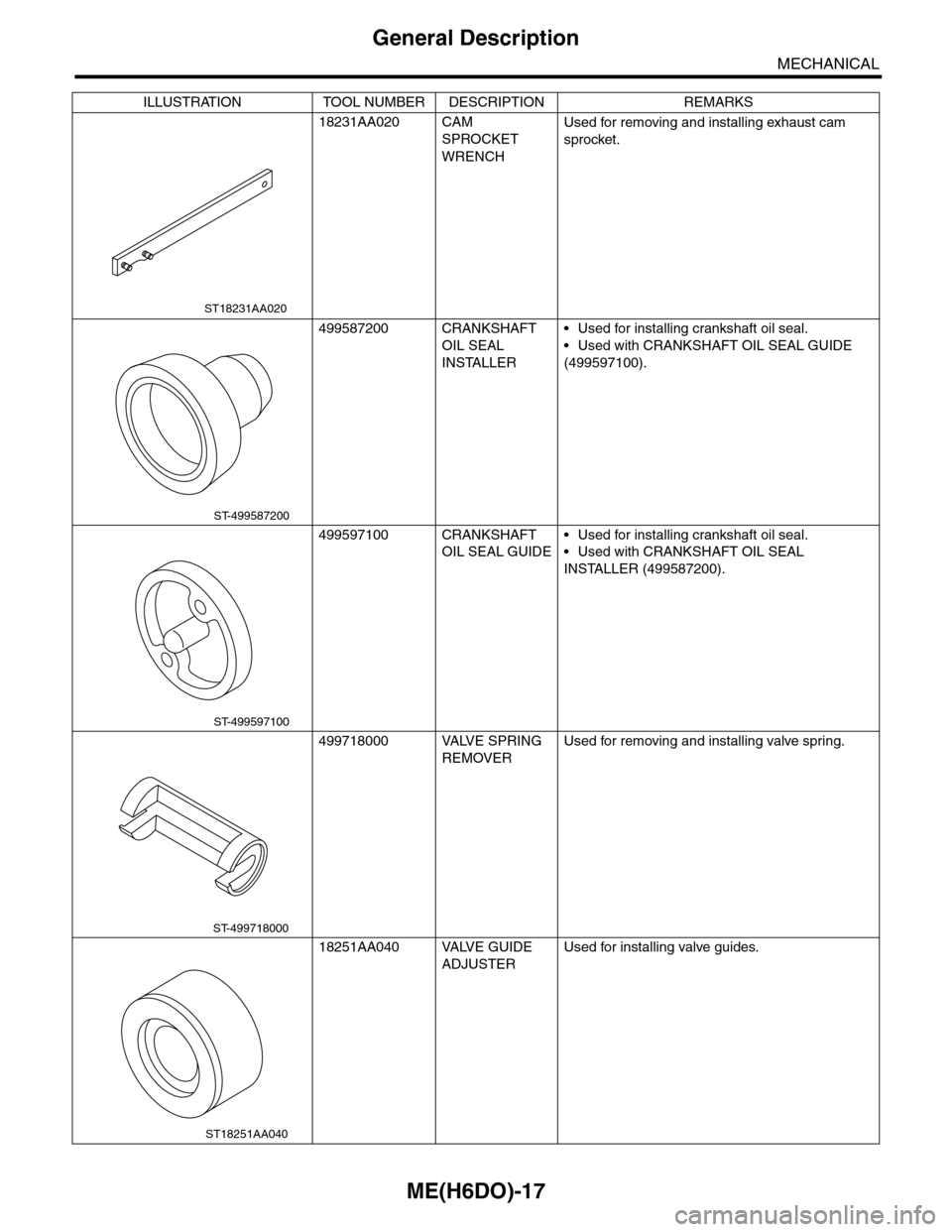
ME(H6DO)-17
General Description
MECHANICAL
18231AA020 CAM
SPROCKET
WRENCH
Used for removing and installing exhaust cam
sprocket.
499587200 CRANKSHAFT
OIL SEAL
INSTALLER
•Used for installing crankshaft oil seal.
•Used with CRANKSHAFT OIL SEAL GUIDE
(499597100).
499597100 CRANKSHAFT
OIL SEAL GUIDE
•Used for installing crankshaft oil seal.
•Used with CRANKSHAFT OIL SEAL
INSTALLER (499587200).
499718000 VALVE SPRING
REMOVER
Used for removing and installing valve spring.
18251AA040 VALVE GUIDE
ADJUSTER
Used for installing valve guides.
ILLUSTRATION TOOL NUMBER DESCRIPTION REMARKS
ST18231AA020
ST-499587200
ST-499597100
ST-499718000
ST18251AA040
Page 1884 of 2453
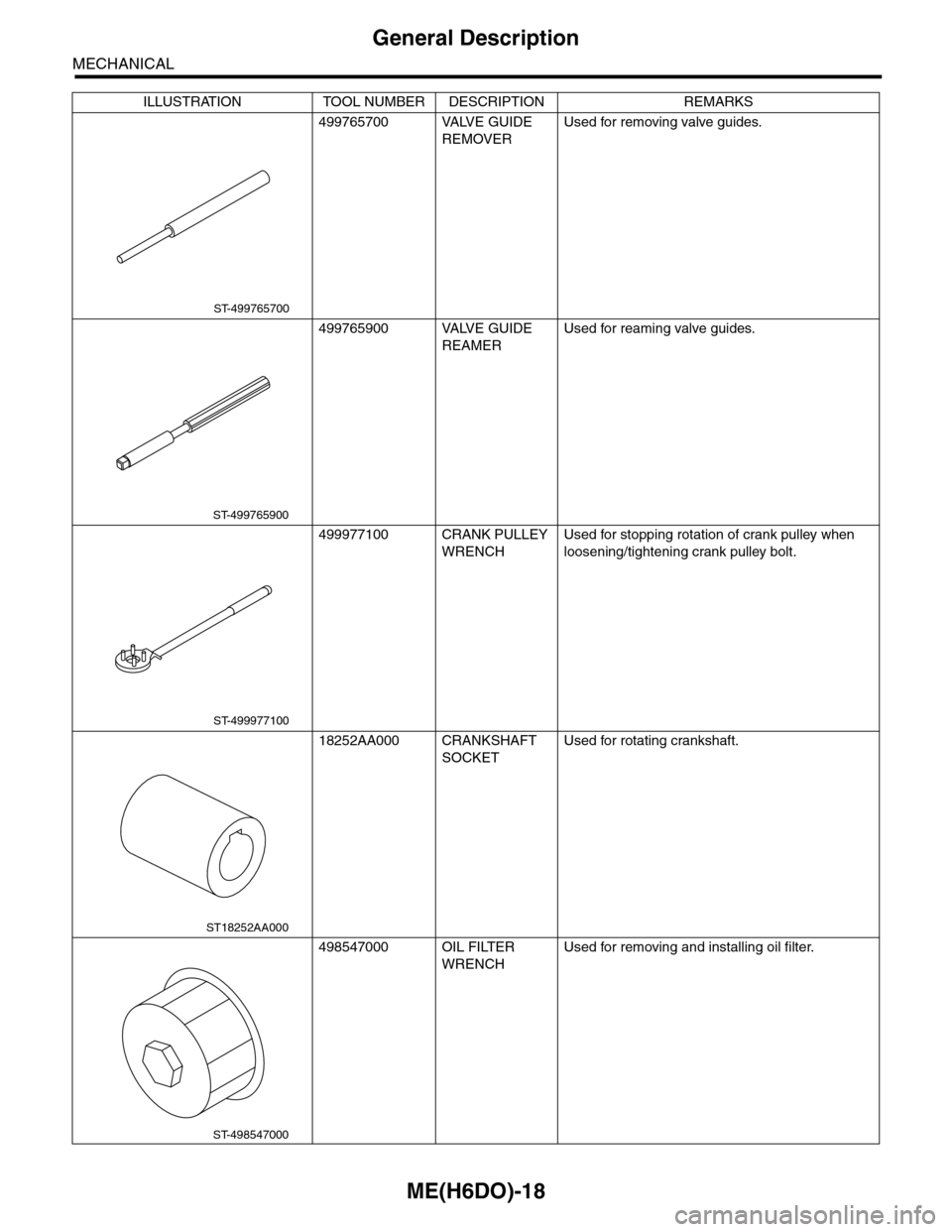
ME(H6DO)-18
General Description
MECHANICAL
499765700 VALVE GUIDE
REMOVER
Used for removing valve guides.
499765900 VALVE GUIDE
REAMER
Used for reaming valve guides.
499977100 CRANK PULLEY
WRENCH
Used for stopping rotation of crank pulley when
loosening/tightening crank pulley bolt.
18252AA000 CRANKSHAFT
SOCKET
Used for rotating crankshaft.
498547000 OIL FILTER
WRENCH
Used for removing and installing oil filter.
ILLUSTRATION TOOL NUMBER DESCRIPTION REMARKS
ST-499765700
ST-499765900
ST-499977100
ST18252AA000
ST-498547000
Page 1885 of 2453
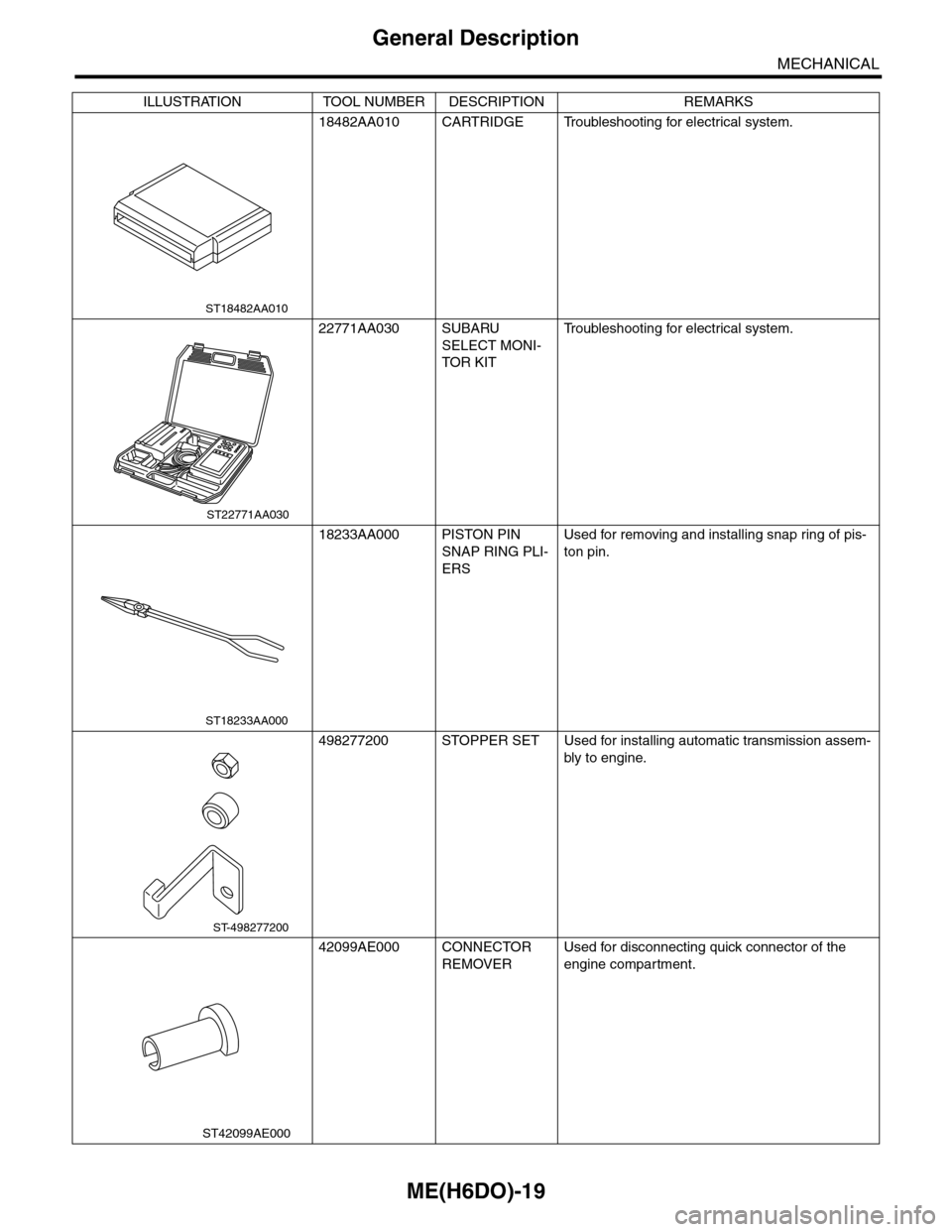
ME(H6DO)-19
General Description
MECHANICAL
18482AA010 CARTRIDGE Troubleshooting for electrical system.
22771AA030 SUBARU
SELECT MONI-
TOR KIT
Tr o u b l e s h o o t i n g f o r e l e c t r i c a l s y s t e m .
18233AA000 PISTON PIN
SNAP RING PLI-
ERS
Used for removing and installing snap ring of pis-
ton pin.
498277200 STOPPER SET Used for installing automatic transmission assem-
bly to engine.
42099AE000 CONNECTOR
REMOVER
Used for disconnecting quick connector of the
engine compartment.
ILLUSTRATION TOOL NUMBER DESCRIPTION REMARKS
ST18482AA010
ST22771AA030
ST18233AA000
ST-498277200
ST42099AE000
Page 1886 of 2453
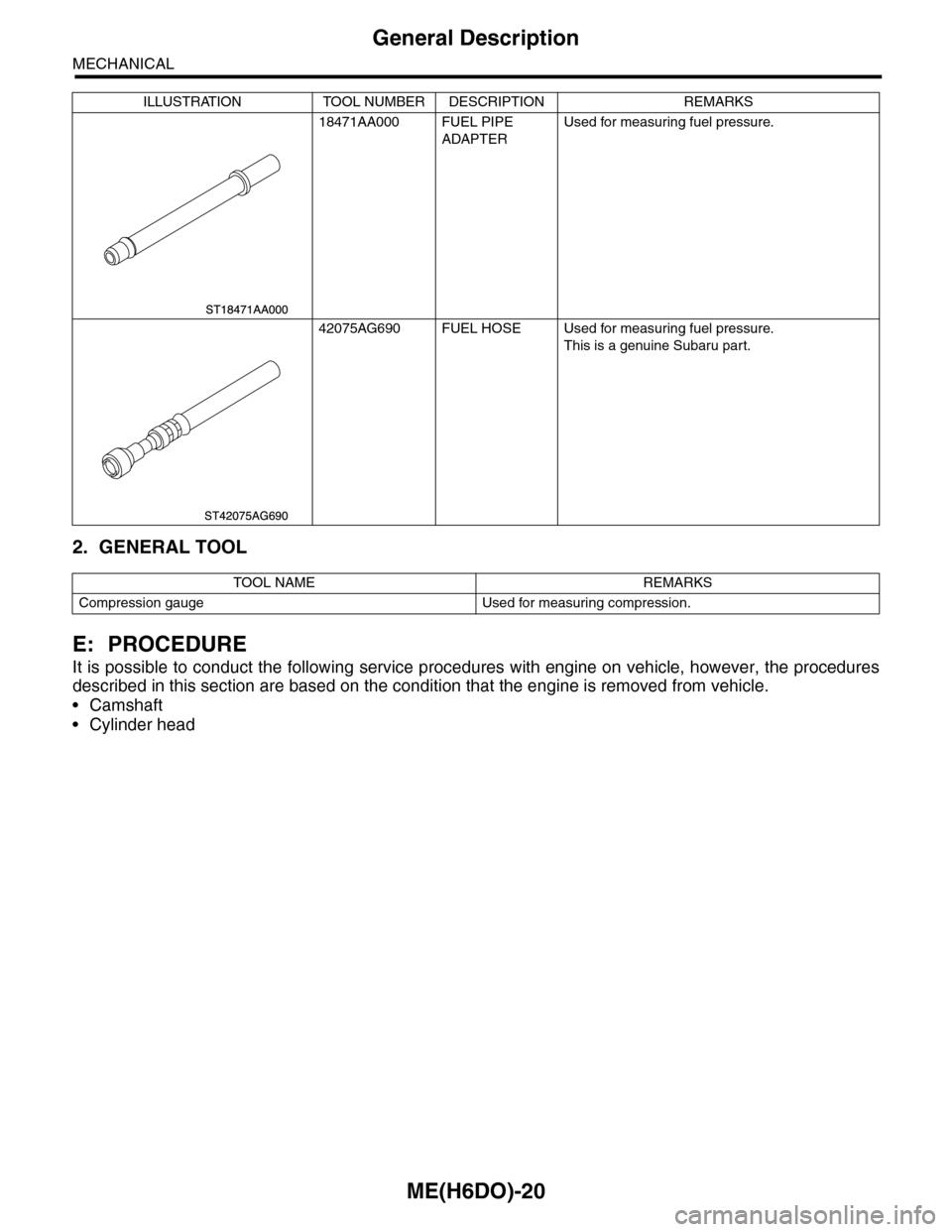
ME(H6DO)-20
General Description
MECHANICAL
2. GENERAL TOOL
E: PROCEDURE
It is possible to conduct the following service procedures with engine on vehicle, however, the procedures
described in this section are based on the condition that the engine is removed from vehicle.
•Camshaft
•Cylinder head
18471AA000 FUEL PIPE
ADAPTER
Used for measuring fuel pressure.
42075AG690 FUEL HOSE Used for measuring fuel pressure.
This is a genuine Subaru part.
TOOL NAME REMARKS
Compression gauge Used for measuring compression.
ILLUSTRATION TOOL NUMBER DESCRIPTION REMARKS
Page 1887 of 2453
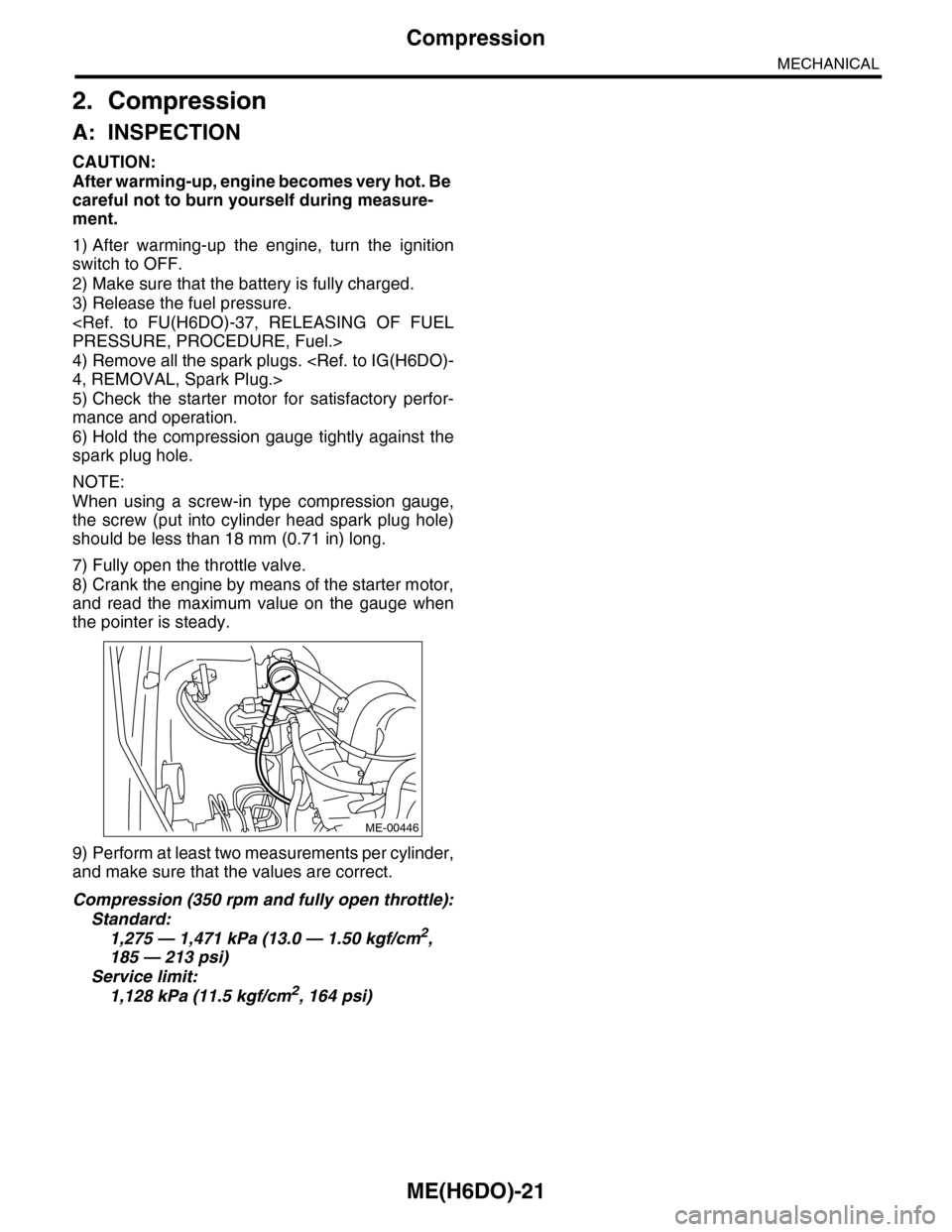
ME(H6DO)-21
Compression
MECHANICAL
2. Compression
A: INSPECTION
CAUTION:
After warming-up, engine becomes very hot. Be
careful not to burn yourself during measure-
ment.
1) After warming-up the engine, turn the ignition
switch to OFF.
2) Make sure that the battery is fully charged.
3) Release the fuel pressure.
4) Remove all the spark plugs.
5) Check the starter motor for satisfactory perfor-
mance and operation.
6) Hold the compression gauge tightly against the
spark plug hole.
NOTE:
When using a screw-in type compression gauge,
the screw (put into cylinder head spark plug hole)
should be less than 18 mm (0.71 in) long.
7) Fully open the throttle valve.
8) Crank the engine by means of the starter motor,
and read the maximum value on the gauge when
the pointer is steady.
9) Perform at least two measurements per cylinder,
and make sure that the values are correct.
Compression (350 rpm and fully open throttle):
Standard:
1,275 — 1,471 kPa (13.0 — 1.50 kgf/cm2,
185 — 213 psi)
Service limit:
1,128 kPa (11.5 kgf/cm2, 164 psi)
ME-00446
Page 1888 of 2453
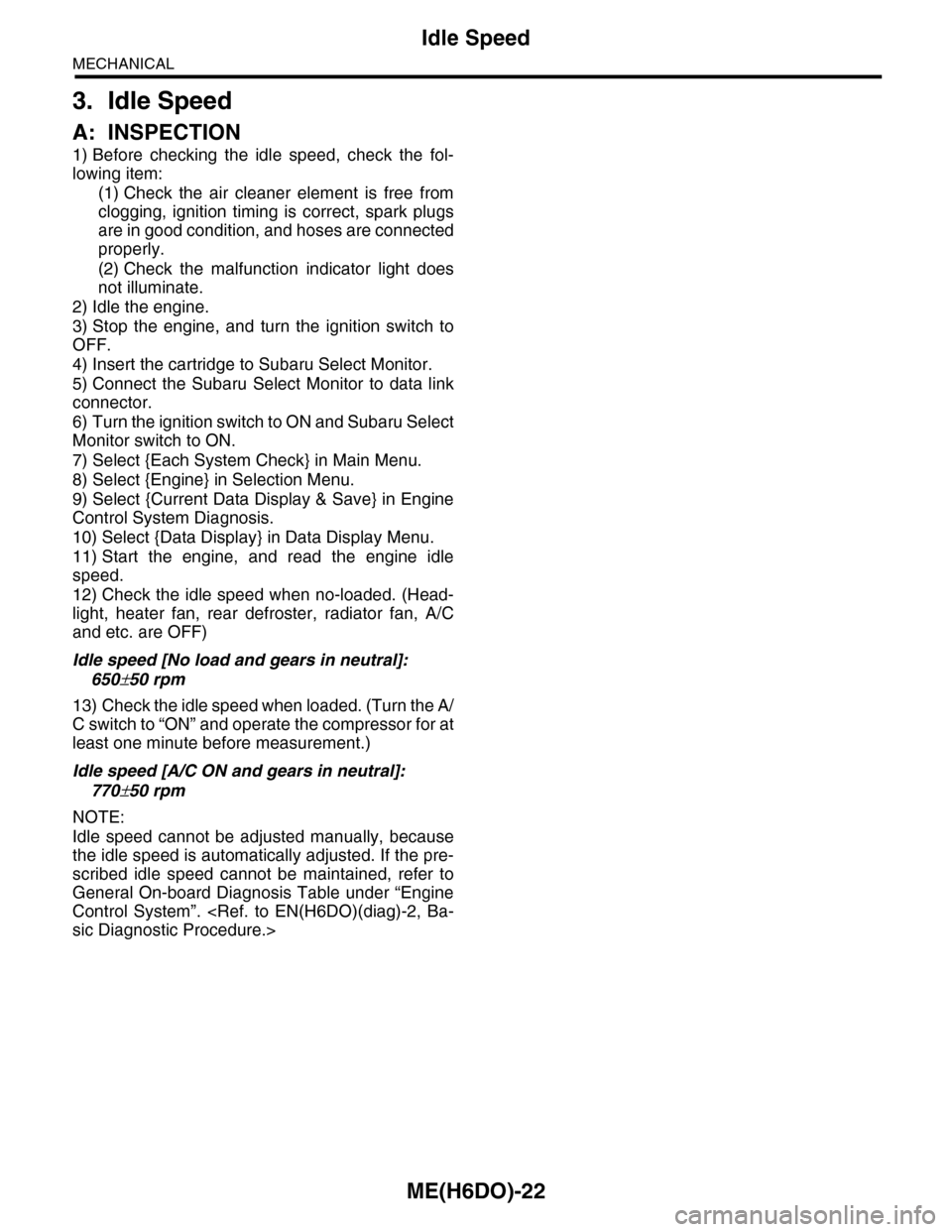
ME(H6DO)-22
Idle Speed
MECHANICAL
3. Idle Speed
A: INSPECTION
1) Before checking the idle speed, check the fol-
lowing item:
(1) Check the air cleaner element is free from
clogging, ignition timing is correct, spark plugs
are in good condition, and hoses are connected
properly.
(2) Check the malfunction indicator light does
not illuminate.
2) Idle the engine.
3) Stop the engine, and turn the ignition switch to
OFF.
4) Insert the cartridge to Subaru Select Monitor.
5) Connect the Subaru Select Monitor to data link
connector.
6) Turn the ignition switch to ON and Subaru Select
Monitor switch to ON.
7) Select {Each System Check} in Main Menu.
8) Select {Engine} in Selection Menu.
9) Select {Current Data Display & Save} in Engine
Control System Diagnosis.
10) Select {Data Display} in Data Display Menu.
11) Start the engine, and read the engine idle
speed.
12) Check the idle speed when no-loaded. (Head-
light, heater fan, rear defroster, radiator fan, A/C
and etc. are OFF)
Idle speed [No load and gears in neutral]:
650±50 rpm
13) Check the idle speed when loaded. (Turn the A/
C switch to “ON” and operate the compressor for at
least one minute before measurement.)
Idle speed [A/C ON and gears in neutral]:
770±50 rpm
NOTE:
Idle speed cannot be adjusted manually, because
the idle speed is automatically adjusted. If the pre-
scribed idle speed cannot be maintained, refer to
General On-board Diagnosis Table under “Engine
Control System”.
Page 1889 of 2453
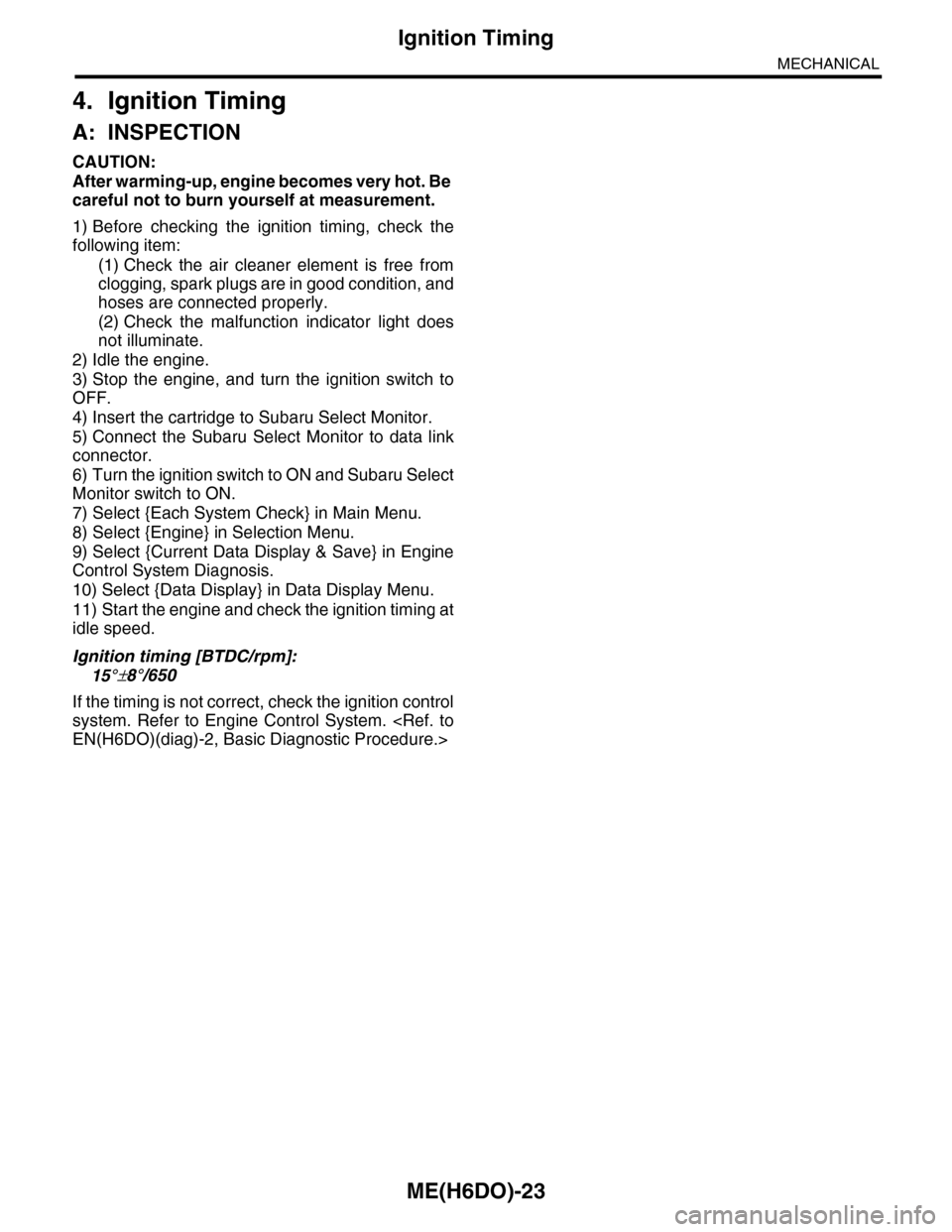
ME(H6DO)-23
Ignition Timing
MECHANICAL
4. Ignition Timing
A: INSPECTION
CAUTION:
After warming-up, engine becomes very hot. Be
careful not to burn yourself at measurement.
1) Before checking the ignition timing, check the
following item:
(1) Check the air cleaner element is free from
clogging, spark plugs are in good condition, and
hoses are connected properly.
(2) Check the malfunction indicator light does
not illuminate.
2) Idle the engine.
3) Stop the engine, and turn the ignition switch to
OFF.
4) Insert the cartridge to Subaru Select Monitor.
5) Connect the Subaru Select Monitor to data link
connector.
6) Turn the ignition switch to ON and Subaru Select
Monitor switch to ON.
7) Select {Each System Check} in Main Menu.
8) Select {Engine} in Selection Menu.
9) Select {Current Data Display & Save} in Engine
Control System Diagnosis.
10) Select {Data Display} in Data Display Menu.
11) Start the engine and check the ignition timing at
idle speed.
Ignition timing [BTDC/rpm]:
15°±8°/650
If the timing is not correct, check the ignition control
system. Refer to Engine Control System.
Page 1890 of 2453
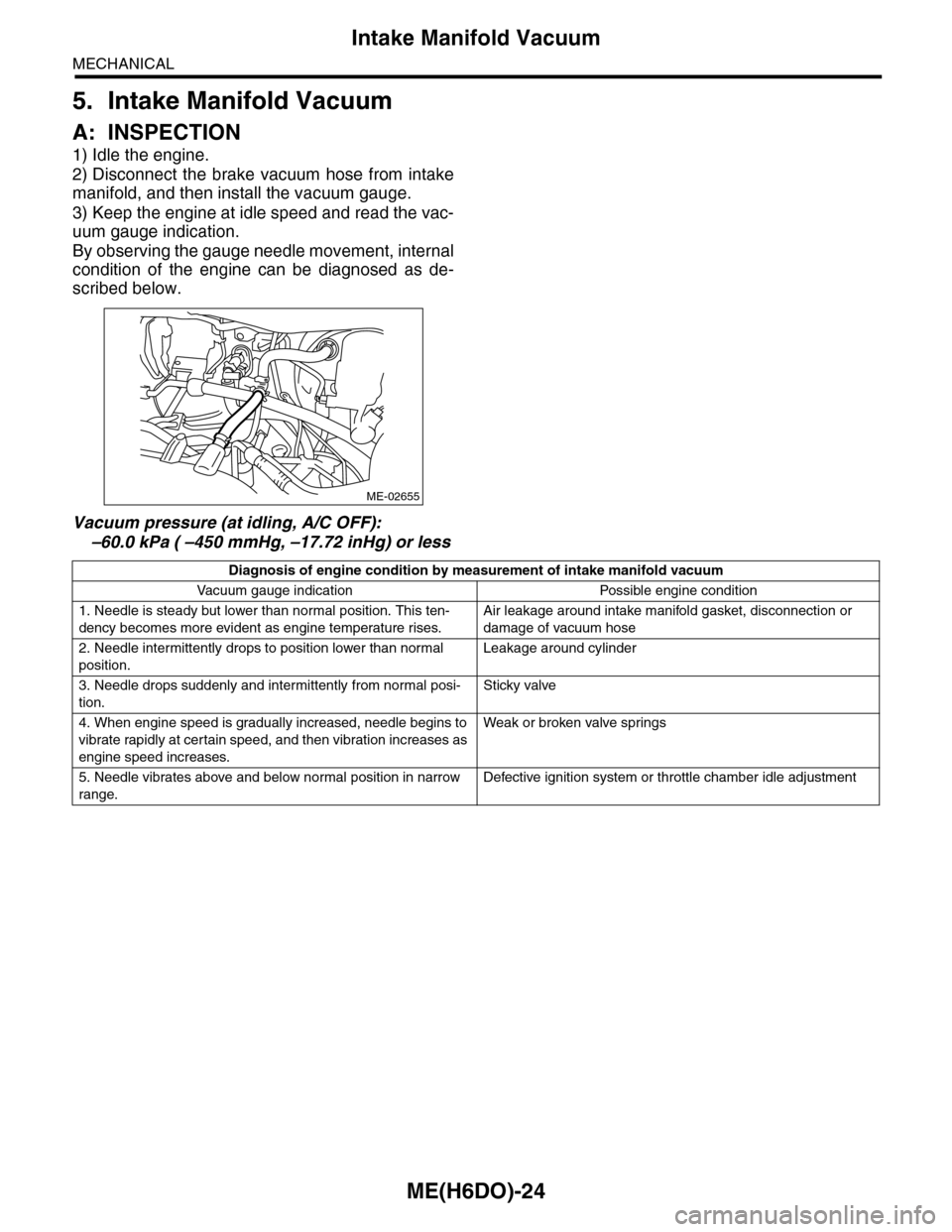
ME(H6DO)-24
Intake Manifold Vacuum
MECHANICAL
5. Intake Manifold Vacuum
A: INSPECTION
1) Idle the engine.
2) Disconnect the brake vacuum hose from intake
manifold, and then install the vacuum gauge.
3) Keep the engine at idle speed and read the vac-
uum gauge indication.
By observing the gauge needle movement, internal
condition of the engine can be diagnosed as de-
scribed below.
Vacuum pressure (at idling, A/C OFF):
–60.0 kPa ( –450 mmHg, –17.72 inHg) or less
ME-02655
Diagnosis of engine condition by measurement of intake manifold vacuum
Va c u u m g a u g e i n d i c a t i o n Po s s i bl e e n g i n e c o n d i t i o n
1. Needle is steady but lower than normal position. This ten-
dency becomes more evident as engine temperature rises.
Air leakage around intake manifold gasket, disconnection or
damage of vacuum hose
2. Needle intermittently drops to position lower than normal
position.
Leakage around cylinder
3. Needle drops suddenly and intermittently from normal posi-
tion.
Sticky valve
4. When engine speed is gradually increased, needle begins to
vibrate rapidly at certain speed, and then vibration increases as
engine speed increases.
Weak or broken valve spr ings
5. Needle vibrates above and below normal position in narrow
range.
Defective ignition system or throttle chamber idle adjustment